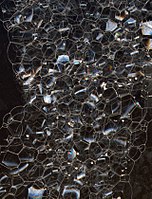
Photo from wikipedia
A surfactant alternating gas (SAG) process is often the injection method for foam, on the basis of its improved injectivity over direct foam injection. In a previous study, we reported… Click to show full abstract
A surfactant alternating gas (SAG) process is often the injection method for foam, on the basis of its improved injectivity over direct foam injection. In a previous study, we reported coreflood experiments on liquid injectivity after foam flooding and liquid injectivity after injection of a gas slug following steady-state foam. Results showed that a period of gas injection is important for the subsequent liquid injectivity. However, the effects of multiple gas and liquid slugs were not explored. In this paper, we present a coreflood study of injectivities of multiple gas and liquid slugs in an SAG process in a field core. Nitrogen and surfactant solution are either coinjected or injected separately into the sandstone core sample. The experiments are conducted at an elevated temperature of 90°C with a backpressure of 40 bar. Differential pressures are measured to quantify gas and liquid injectivities. Computed tomography (CT) scanning is applied to relate water saturation to mobility. During the injection of a large gas slug following foam, a bank in which foam completely collapses or greatly weakens forms near the inlet and propagates slowly downstream. During the subsequent period of liquid injection, liquid flows through the collapsed-foam bank much more easily than further downstream. Beyond the collapsed-foam region, liquid first imbibes into the whole cross section. In this region, liquid flows mainly through a finger of high liquid saturation. Our CT results suggest a revision of our earlier interpretation; the process of gas dissolution does not merely follow fingering but is evidently directly involved in the fingering process. Our results suggest that, in radial flow, the small region of foam collapse very near the well greatly improves injectivity. The subsequent gas and liquid slugs behave near the wellbore, affecting injectivity, in a way similar to the first slugs. Thus, the behavior and modeling of the first gas slug and first subsequent liquid slug is representative of near-well behavior in an SAG process. The trends observed in our previous work are reproduced in a low-permeability field core.
Journal Title: Spe Journal
Year Published: 2020
Link to full text (if available)
Share on Social Media: Sign Up to like & get
recommendations!